Egypt: Western Desert to Red Sea and Alexandria to Abu Simbel
 |
| The rabbit formation at White Desert of Egypt |
In March of 2023, we got together with a number of family members and close friends and embarked on a tour of The Arab Republic of Egypt from its Western desert to Red Sea and Alexandria to Abu Simbel, thus covering almost the entire country except Sinai peninsula.
Here is a map of our Egypt trip.
From Cairo, we drove to Bahariya Oasis to visit Crystal Mountain, White Desert and Black Desert in Egypt's Western Desert. Returning to Cairo, we visited the Giza pyramids, Egyptian Museum and bazaars and drove up to Alexandria. We then flew down to Aswan where we visited Abu Simbel before cruising up river Nile from Aswan to Luxor stopping at the many important historical complexes. We finally drove to Hurghada where we relaxed for a bit and headed home.
Cairo
March 11, 2023
 |
| Nile river in Cairo from hotel room looking south: 6th October Bridge right below, Qasr El Nil Bridge further down |
We landed at Cairo International Airport and checked in to our hotel in downtown Cairo on the east bank of river Nile next to the 6th of October bridge. We had a pretty view of the city and the river from the balcony of our room at the Ramses Hilton.
Western Desert of Egypt: Bahariya Oasis, Crystal Mountain, White Desert and Black Desert
March 12, 2023
About 250 miles southwest of Cairo, deep in the Western Desert of Egypt near the Lebanon border, lies a water-filled depression forming the Bahariya Oasis and its associated lush 800 square mile valley. The valley operated many wineries and was a primary source of wine during the age of pharaohs in ancient Egypt. In modern times the valley is known for its excellent dates and olives.
We start early at 6:30 AM from our hotel in Cairo. It is a 5 hour drive from downtown Cairo to Bahariya Oasis. At the oasis, we switch vehicles and strap ourselves into rugged 4x4 off-road Land Cruisers. We then head deep into the dunes of the eastern Sahara.
 |
| The Western Desert of Egypt (Libyan Desert) at border with Libya |
Our dextrous drivers demonstrate remarkable skill driving up mountain-sized sand dunes and then down their slopes causing much excitement in us poor passengers hanging on from the interior handles of Toyota Land Cruisers for our dear lives.
Crystal Mountain
The first stop is Crystal Mountain which is a remarkable shining ridge on the desert trail towards Farafra Oasis at the edge of the White Desert southwest of Bahariya Oasis. Composed of quartzite crystals, it glitters in the sunlight like a royal crown endowed with a billion jewels.
Breaking off crystals from the mountain side or picking up loose crystals lying around would cause irreversible damage to the unique natural wonder and is strictly prohibited, a rule that is fortunately enforced diligently by tour operators.
It is hot and sandstorm-force winds are blowing. We decided to not risk the climb up to the summit of the mountain although many other visitors do so.
White Desert
 |
| White Desert, Egypt rock formations: the Mushroom and the Rooster |
Also located within the Western Desert, the White Desert takes its name from spectacular white rock formations sculpted by wind and sand. It is surrounded by cliffs of the Farafra depression and sand dunes.
 | |
|
Mounds, hills and rolling waves of quartz crystal, white calcium carbonate, limestone and chalk overlaying orange-colored Sahara sand result in a surreal landscape. The Crystal Mountain that we came from is the tallest of such formation in the White Desert.


The rocks and erosion-sculpted formations of the White Desert are mostly made of calcium carbonate giving them their unusual color of white chalk.
Tea in the Sahara
Watch: Tea and snacks in a tent in the White Desert of Egypt
The Bedouin are ancient nomads of the great African and Arabian deserts. Visitors to the White Desert with more time in their hands can camp with Bedouins in the desert under the stars. We are unfortunately limited by our schedule to a day-trip. Regardless, we were offered tea and snacks as well as some music and entertainment in a pretty tent before heading off to our next stop.
Black Desert
The Black Desert lies between Bahariya Oasis and the White Desert. Unlike the White Desert, the hills and mounds of the Black Desert are shaped by volcanic activity in the hills around it with basalt, volcanic dolerite and iron quartzite deposited by eruptions giving them a dark hue. Reddish mounds are also seen here due to the presence of iron sandstone.
Before starting the long drive back to Cairo, we are served a sumptuous dinner at Ahmed Safari Camp in Bawiti.
Pyramids of Giza, Great Sphinx, Egyptian Museum in Cairo and Papyrus Shopping
March 13, 2023
We start the day by crossing the 6th of October bridge over river Nile again to head southwest to the pyramid complex at Giza. The great pyramid of Khufu (Greeks call him Cheops) that remained the tallest man-made structure for 3,800 years, the Great Sphinx and their other world-famous companions await us.
Pyramids of Giza, Great Sphinx and Camel Ride
In addition to the pyramids of Khufu (Great Pyramid), Khufu's son Khafre and Khafre's son Menkaure, the Giza necropolis (pyramid complex) includes the Great Sphinx, temples, cemeteries and ruins of a workers' village. All construction here took place between 2600 and 2500 BCE during the Fourth Dynasty of the Old Kingdom of ancient Egypt.
The Great Pyramid of Khufu (Cheops) remains a mystery to this day with no definitive answers on how it was constructed. Especially troublesome is the question of how huge blocks of solid red granite weighing 50 to 80 tons each brought in from Aswan 580 miles to the south by river Nile were placed deep inside the pyramid around the King's Chamber including its ceiling. In addition, archeologists are still finding their way around it, with a mysterious 30-foot chamber found inside it a few days ago using cosmic-ray muon detectors!
 |
| The Great Pyramid (Pyramid of Khufu) |
 |
| The Great Sphinx |
 |
| Pyramid of Menkaure |
A few of the highly polished bright white casing stones are still present at the top of Khafre’s pyramid. Many casing stones from the sides of the pyramids were pillaged between 14th and 19th centuries to build churches, mosques and other structures. Earthquakes caused some more to come loose and drop to the ground. Over millennia, pollution and weather too have contributed to the current sad look of the great pyramids of Giza.
 |
| Pyramid of Khafre |
 |
| The Great Pyramid (Pyramid of Khufu) |
 |
| The Great Pyramid (Pyramid of Khufu) |
Temples, cemeteries and remains of a workers' village are also part of the Pyramid Complex of Giza.
Finally, a camel ride in the desert is mandatory for every visitor to the great pyramid complex of Giza and we do not make an exception!
Egyptian Papyrus

In ancient Egypt the aquatic plant Cyperus papyrus thrived around the area of Nile river delta where the river spreads out to drain into the Mediterranean sea. Over 5,000 years ago in early Bronze age, the Egyptians were the first to figure out that the soft spongy inner layers of these plants (the pith) made excellent surfaces to write on. Sheets made of papyrus could be joined side by side, written on and rolled up creating scrolls.
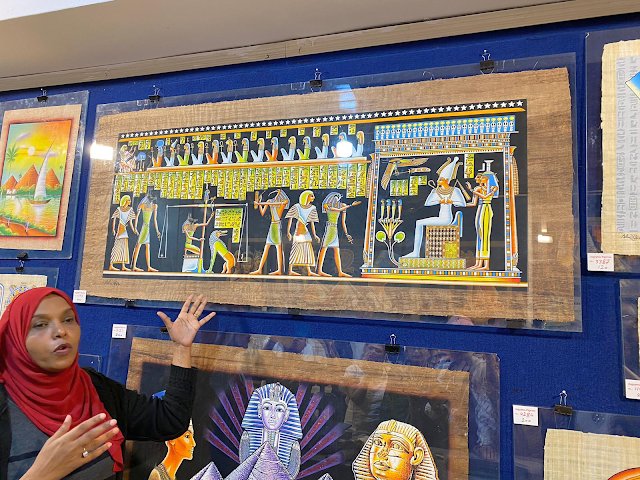 |
| A guide explains the history and art of papyrus creation, writing and painting |
Today, Al-Qaramus village, about 50 miles northeast of Cairo, is Egypt's largest hub of papyrus production catering to huge numbers of papyrus-seeking tourists.
We too visit a papyrus store in Cairo, one of the places where the art of papyrus creation is demonstrated and scrolls of pre-painted or custom calligraphed and painted papyrus sold.
The Egyptian Museum, Cairo
Egyptian History in one place! Inaugurated in 1902, the The Egyptian Museum of Cairo catalogues and showcases the world's largest collection of valuable archeological artefacts from over the entire history of ancient Egypt spanning over 3,000 years.
Tutankhamun’s mask
The most popular exhibit of the Cairo museum is the 3,300 year old Mask of Tutankhamun, though King Tut himself can be seen resting peacefully in the Tomb Of Tutankhamun at Valley Of The Kings , Luxor that we will visit later.
There is a gory back story to Tutankhamun’s mask as told succinctly by The Art Newspaper: "During Tutankhamun’s funeral, priests poured such large amounts of resin over his mummy that when it solidified, the body, and the gold mask it wore, were left glued to the coffin. To free them, Carter resorted to drastic measures. First, he and his team dismembered Tutankhamun, making it easier for them to remove the pieces of the king’s body and reassemble them on a tray. But the gold mask—and Tutankhamun’s severed head within—remained in place. Carter used heated knives to melt the resin holding Tutankhamun’s head inside the mask, and later, hung the coffin upside down over paraffin lamps to free the mask itself. This melted the resin, but also loosened many of the mask’s inlays, causing them to fall out of place. Carter had to spend days putting them back in position."
Tutankhamun's Canopic Shrine
King Tut's gold-covered oak canopic shrine is also on display at the Egyptian Museum. Such beautifully decorated shrines were used to store four canopic jars containing organs from the body being mummified. The jars and the organs in them were under protection of four sons of Horus and Hathor: Hapi for lungs, Imsety for liver, Duamutef for stomach and Qebehsenuef for intestines.
 |
| Tutankhamun's Golden Canopic Shrine: gold-covered oak, Cairo Museum |
Guardian of the Tomb of Tutankhamun
This and other gilded wooden guardian statues were found in King Tutankhamun's burial chamber.
Anubis from Tutankhamun's Tomb
The best known sculpture of jackal-headed Anubis, god of the dead, protector of tombs and gatekeeper for the underworld, was found wearing a shawl in Tutankhamun's burial chamber in front of the shrine holding King Tut's canopic chest.
 |
| Anubis, Egyptian Museum, Cairo |
King Khufu (Cheops)
On display in the museum is a little 3-inch high ivory statue of pharaoh Khufu (c.2609-2584 BCE) who commissioned the Great Pyramid of Giza. This is the only complete portrait of Khufu found so far.
 |
| Statue of King Khufu (Cheops), Egyptian Museum, Cairo |
King Khafre
There is a beautiful statue of fourth dynasty king Khafre (c.2575–2465 BCE), son of king Khufu. It is Khafre's pyramid in Giza that still has a few original white casing stones intact at its top.
 |
| Statue of King Khafre, Egyptian Museum, Cairo |
Unfinished Head of Nefertiti
This is an unfinished brown quartzite stone bust of the famous 18th dynasty queen Nefertiti (c.1370-1330 BCE), wife of Pharaoh Akhenaten.
 |
| Bust of Queen Nefertiti, Egyptian Museum, Cairo |
Mummy of Thuya the Woman
The tomb of the ancient Egyptian noble Yuya and his wife Thuya (c.1375 BCE), parents of queen Tiye (wife of pharaoh Amenhotep III) and distinguished nobleman Anen, was discovered in February 1905 in the Valley of the Kings (Tomb KV46). Despite looting by tomb raiders over the centuries, the undecorated tomb preserved a great deal of its original contents including chests, beds, chairs, a chariot and numerous storage jars. In addition, disturbed but undamaged mummies of Yuya and Thuya were found within their coffins. This tomb was considered the greatest discovery in Egyptology until the tomb of Tutankhamun.

 |
| Mummy of Thuya, Egyptian Museum, Cairo |
A chest, jars and items found in the tomb of Yuya and Thuya are on display.

King Menkaure Triad Statues
Pharaoh Menkaure (c.2532-2500 BCE, known in Greece as Mykerinos) from fourth dynasty of the old kingdom appears as the central figure in these triad statues. In all three triads, goddess Hathor to his right holds the sun in her crown with horns. On his left in each triad is the deity of a specific nome (administrative district with a local head called the nomarch) of upper Egypt. In the rightmost triad, the 17th nome of upper Egypt (Anubis land) is represented indicated by the jackal.
Artefacts Everywhere
Choke full of ancient artefacts, the Egyptian Museum in Cairo is a place to spend days or weeks at. Sadly, we are on a schedule that is too tight to do it justice.
Alexandria
March 14, 2023
My personal fascination with Alexandria started at age 16 when I read what Carl Sagan had to say about it in his seminal book Cosmos. Alexander the Great of Macedonia, Greece conquered Egypt and founded the city of Alexandria as his capital in 331 BCE. For the next 275 years Egypt was ruled by a dynasty of Ptolemaic Pharaohs who were not Egyptians but Macedonian Greeks. The Ptolemaic Pharaoh dynasty is named after king Ptolemy I Soter, the Macedonian Greek general of Alexander who founded the Ptolemaic Kingdom after Alexander's death in 323 BCE, and Queen Berenice I also originally from Macedonia. They were the last ruling dynasty in Egypt.
The Romans subsequently invaded and conquered Egypt in 30 BCE. Alexandria continued to be the capital under Roman rule till the 7th century CE Arab conquest of Egypt. The Arabs then moved the capital to what is now Cairo.
Alexandria at its peak was the largest city of the world of its time, losing that status later only to Rome. It was the center of science, arts, culture and knowledge in the Mediterranean during its Greek and early Roman period. Pharos - the Lighthouse of Alexandria, the Great Library and the Catacombs of Kom El Shoqafa were wonders of the world.
Alexandria has been hit by multiple disastrous earthquakes with an especially violent one in 535 CE which likely took out a good part of the city and its grand architecture. However Alexandria still remains the largest city in the Mediterranean today.
We start driving early in the morning to cover the 136 miles from Cairo to Alexandria. It is a 2 and a 1/2 hour drive on the Cairo–Alexandria Desert Road (Egypt Route 75M) toll road.
Roman Theater
Historical records indicate Alexandria once had around 400 Roman theaters but this is the only one found and excavated so far. It was a typical Roman open-air amphitheater with seating capacity of 800 in 13 circular rows of white marble supported by granite columns and thick limestone walls. Like the pyramids of Giza and granite used across the entire country over its history, the granite was brought in from faraway Aswan in southern Egypt.
There are remains of five covered rooms with dome roofs above general audience seating rows. VIPs must have watched events from these special rooms protected from the elements. There were also two forecourts with mosaic flooring.

Roman Baths
There are well-preserved ruins of Roman thermae (baths) to the left of the amphitheater featuring a series of wood furnace-heated rooms and hot baths, a cold pool (frigidarium) and normal "warm" baths typical for elaborate three-stage Roman baths of the period.

Frigidarium
There was a frigidarium to the north side of the main heated Roman baths. A frigidarium (cold room) is one of the three main bath chambers of a Roman bath or thermae often containing a swimming pool. The water here was kept cold using snow and ice, sometimes brought in from far away. Athletes and people on hot days would use the frigidarium to cool down. A bath at a frigidarium was also taken after the warm and hot baths to close skin pores.
 |
| The Frigidarium at Roman Bath of Alexandria |
Pompey's Pillar

Standing next to the ruins of Serapeum of Alexandria (Serapis temple), Pompey's Pillar is an impressive 88-foot 285 ton Corinthian column built from monolithic Aswan red granite around 300 CE to honor Roman emperor Diocletian (c. 242-312 CE). There used to be a great statue of the emperor at the top of the column. The statue probably toppled in an earthquake and has not been found.
The column has nothing to do with Pompeii; the modern name of the column is a result of misreading of inscriptions at the base of the column which should really be named "Diocletian's Pillar". There are two Sphinx monuments at the sides of the pillar that were made by Romans using pink granite possibly from Corsica. The Sphinxes are older than the pillar and come across as smaller copies of the Great Sphinx of Giza.
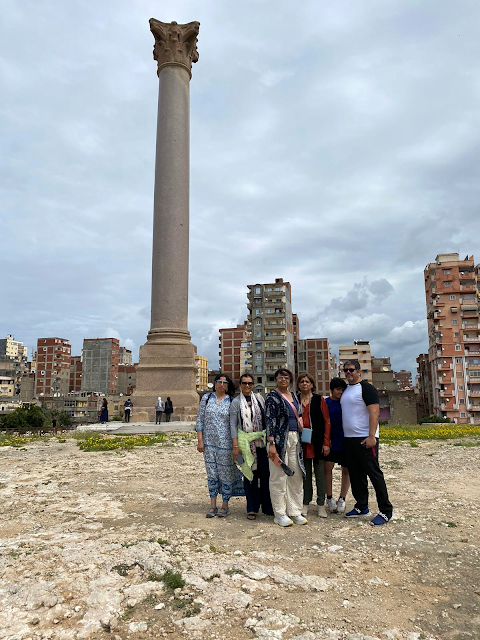
Pompey's Pillar is among the very few ancient monuments still standing at its original location today.
Catacombs of Kom El Shoqafa

The catacombs of Kom El Shoqafa are one of the Seven Wonders of the Medieval World. Dating back to c.200 CE, a circular staircase leads deep down into three levels of cemetery cut through solid bedrock. Corpses were carried down these stairs for funerary rituals and put into their designated tombs or places of final rest carved into bedrock walls.
 |
| Catacombs of Kom El Shoqafa: Spiral staircase deep down into Necropolis |
The necropolis contains elaborate tombs, monuments, statues and artefacts that demonstrate a unique confluence of Egyptian, Greek and Roman art and culture.
There actually is a room with benches (called exedra) for folks to sit down and rest after the long climb down the spiral stairs.

The entrance to the principal tomb chamber is elaborately decorated. Agathos Daimon, the Egyptian-Greek household God of health and luck popular in Alexandria, flanks both sides of the entrance and is also carved in other places.

Being a place for people to travel from this world to the underworld, Lord Anubis - the gatekeeper to the underworld - is of course around guarding doors. He manifests with wolf heads here.

There are three huge sealed stone sarcophagi along the walls of the principal tomb chamber. Each has its own decorated panel with intricately sculpted bas-relief art. The panel of the sarcophagus in the middle wall has a sculpture of wolf-headed Anubis wearing Roman soldier garb mummifying a body. The panels of the other two sarcophagi along the sidewalls have sculptures of the sacred Apis Bull, son of goddess Hathor, receiving a gift.

A bunch of human and horse bones were found in the catacombs. Nobody really knows the origin of these bones despite a popular but unproven legend of these being bones of young Christian men massacred by Roman emperor Caracalla (188–217 CE) in 215 AD. The massacre did happen and was one of many instigated by Caracalla i.e. Marcus Aurelius Antoninus.
Tigrane Tomb
Often referred to as the "Painted Tomb", Tigrane Tomb is one of the tombs in the Kom El Shoqafa complex.
Tigran Tomb is named after its location on Tigrane Pasha Street. Dating back to the 2nd Century CE, the tomb with two sarcophagi is beautifully painted with a narrative on the walls and the dome ceiling. An interpretation of the artwork can be found here.
At the end of a long day in Alexandria, we drive back to Cairo and overnight at our downtown hotel.
Aswan: High Dam and Philae Temple
March 15, 2023
We fly from Cairo to Aswan early in the morning.
 |
| Aswan International Airport |
Aswan

Aswan is essentially a timeless frontier city in southern Egypt on the trade route with ancient bazaars and access via river Nile to rest of Egypt and north Africa. Known as Swenett and Syene at various points in its chequered history, Aswan is also the source of gigantic blocks of desirable red syenite granite used in countless statues, obelisks, monoliths, pyramids, temples and shrines by ancient Egyptians, Macedonian Greeks, Romans and Arabs. Relics of 3,000-year old stone quarries and the men working there are still visible on either side of the Nile.
Aswan High Dam
 |
| A dog inspects downstream (north) outflow from Aswan High Dam |
Since ancient times the Nile river had been unpredictable in its flood and drought cycles.. Towards the end of 19th century, the British attempted at building a dam now called the Aswan Low Dam or Old Aswan Dam at the first cataract of Nile of that time (map). Despite architectural adjustments for over 30 years, the old dam failed to meet irrigation requirements, although currently it runs the 280 MW Aswan I and 270 MW Aswan II hydroelectric power plants.
In 1960, armed with modern technology, the Egyptians under governance of President Gamal Abdel Nasser decided to try to tame the Nile by building a dam at its second cataract. The result is the High Dam of Aswan (map), a remarkable feat of engineering that took 10 years to complete. The dam was built in the aftermath of the geopolitical Suez Crisis of the 20th century.
Measuring 12,500 feet long and 3,300 feet wide, the High Dam continues to stand today as one of the largest earthen embankment dams ever built in the world. It created Lake Nasser that submerged the second cataract of the Nile and holds back some 32 cubic miles of water allowing controlled flow protecting people, farmers and crops from devastating floods and drought as well as running the 2,100 MW Aswan High Dam Hydroelectric Power Plant. The temples of Philae and Abu Simbel are among entire ancient monuments rescued from inundation by lake Nasser by moving them to safer locations.
Philae Temple (on Agilkia island)
 |
Aswan to Philae Temple Ferry & Boat Jetty |
In c.280 BCE, King Ptolemy II Philadelphus, son of King Ptolemy I Soter who founded the Macedonian-Greek Ptolemaic Kingdom of Egypt and Queen Berenice I, commissioned the construction of a major temple complex dedicated to Isis the great goddess of healing and magic, her brother-husband and god of underworld and the dead Osiris, and their son Horus the shape-shifting god of healing, protection, the sun and the sky, on the now-submerged island of Philae.
The Isis temple complex itself was completed by successor King Ptolemy III Euergetes. Later after Rome took Egypt over, Roman emperor Hadrian added the gate named after him. The complex also contains temples of Imhotep, Hathor, Osiris, Horus and Nephthys.
 |
Philae Temple: Agilkia island jetty / dock |
The island of Philae was located between what is today the Aswan Low Dam in the north and Aswan High Dam in the south, an area of Nile river water between the first and second cataracts that sees major cyclical jumps in water level. Philae found it difficult to stay above water when the Aswan Low Dam was built by the British and would frequently become submerged. By the time the Aswan High Dam project came along, Philae faced inevitable total submersion.
 |
| Temple of Isis, Philae |
In a remarkable and successful rescue effort, the Egyptian government and UNESCO came together to barricade Philae and pump it dry, and then proceed to relocate the entire temple complex to its current location on the nearby island of Agilkia. Over 50,000 stones and architectural pieces were individually moved and reassembled on Agilkia!
However, nobody calls it the Agilkia Temple. It was and always will be the Philae Temple, and one of the most attractive and popular sites for visitors to Egypt.

We return by boat to Aswan.

Back in Aswan, we check into the Jaz Celebrity our cruise ship for the night. Tonight is the first of three nights we will spend on the ship as part of our Nile river cruise.
 |
| The Jaz Celebrity Nile River Cruise Ship |
 |
| On Board the Jaz Celebrity Nile River Cruise Ship |
Abu Simbel
March 16, 2023
We spent a short night in our cabins on board the Jaz Celebrity docked at Aswan Nile River Cruise Port, getting up very early to start our drive to Abu Simbel at 4 AM. Abu Simbel is around 180 miles to the south of Aswan and just 13 miles short of international border with the Sudan. It takes around 3 hours to get there. There are military police checkpoints due to security concerns along the road (the previous mandatory military escorted tourist convoys are no longer running).
Look - a Mirage!
 |
| A mirage seen on the Aswan - Abu Simbel Highway |
Mirages are seen frequently on Abu Simbel Rd (Egypt Route 75M). In the picture above, the blue water out in the distance, especially prominent towards the right half, does not exist.
Abu Simbel
 |
| The adventures of Tintin: Cigars of the Pharaoh Sophocles Sarcophagus goes mad and thinks he is Ramesses II |
The 13th-century BCE Abu Simbel complex consists of two gigantic temples cut out from rock in the mountain. Along with the pyramids of Giza, the four colossal rock sculptures of Pharaoh Ramesses II (Ramesses the Great, Ozymandias to Greeks) sitting next to the entrance of the Great Temple of Abu Simbel are among the most recognized icons of ancient Egypt in popular culture across the world. Next to the Great Temple is the Small Temple of Abu Simbel dedicated to goddess Hathor and Queen Nefertari who was the first and most beloved of the Great Royal Wives of Ramesses II.

Like the Philae temple complex, the Abu Simbel temples were relocated from their original location which was about to drown in Lake Nasser as a result of construction of the Aswan High Dam. In 1968, the original temples were cut into 20 to 30 ton blocks of stone that were transported and reassembled at the current location.
Great Temple of Abu Simbel
Four colossal 66-foot statues of Ramesses the Great sitting on thrones staring down at us welcome us as we approach the Great Temple. The sheer scale of the monument has the intended effect and much more. (Pieces of one statue that broke off in an earthquake, including the huge head and crown, are on the ground exactly at the positions they were at before the big move.)
There are more statues snuggling around the ankles of great legs of Ramesses II. These statues, smaller than his lower legs not quite reaching his knees, are of family members of Ramesses II: Queen Nefertari, his mother, eldest two sons and eldest six daughters. Creator sun god Amun-Ra is carved into stone above the entrance door with Ramesses II depicted in bas-relief worshipping Ra on both sides.
So what did the exterior of the Great Temple originally look like? Here is one artist's rendition that attempt at it, courtesy of Art Now and Then blog:
 |
| An artist's impression of the Great Temple of Abu Simbel in its original painted colors Image courtesy: Art Now and Then |
Inside the temple, we cross the first of two majestic hallways with many side-rooms and vestibules. The Pharaohs had successfully elevated themselves from mortal monarchs to gods. Ramesses II was no exception and the Abu Simbel complex is partly designed to reinforce the divine aspect of pharaohs. The first hall (Great Hall of the Great Temple of Abu Simbel) has eight pillar statues of god Osiris with the face of Ramesses II. The walls are decorated with bas-relief art mostly depicting scenes of great battles and victorious conquests.
We enter the second hallway. It is smaller than the outer hall and has four pillars decorated with art depicting Ramesses II and Nefertari with sacred boats of Amun and Ra-Horakhty and offerings to the gods.
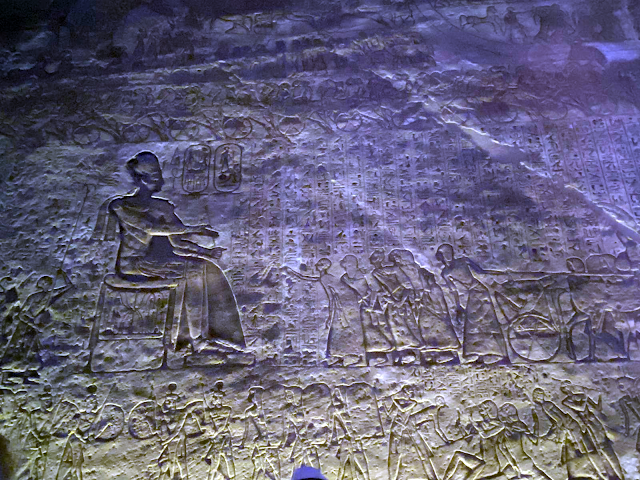
We continue to another vestibule and across it into the inner sanctuary. Ramesses II is definitely among the gods here. He is sitting second from right next to gods Ptah (at left), Amun-Ra and Ra-Horakhty. Magic happens here on February 22 and October 22 every year when rays of the rising sun shine right through the entrance and hallways of the temple to vividly light up the sitting foursome.
Small Temple of Abu Simbel
The smaller temple right across is dedicated to queen Nefertari and goddess Hathor. Unusually for ancient Egyptian monuments, the king and queen are depicted in an equal scale here. At the front of the temple there are four 33-foot sculptures of the king and two of the queen, all standing unlike the bigger temple. Little princes and princesses are sculpted around their ankles, no taller than their knees in height.
We enter the first big hall of Nefertari's temple.
Built in a smaller scale with a layout similar to the bigger temple, the first hallway has six pillar sculptures depicting queen Nefertari.

Bas-relief art on stone walls include scenes of battle where the king and queen together vanquish their enemy. Scenes of queen Nefertari making offerings to goddesses Hathor and Mut are also depicted on the walls.
There is a vestibule after the main hallway. At the end walls of the vestibule, there are bas-reliefs of the king and the queen offering papyrus plants to goddess Hathor in the form of a cow on a boat on water with papyrus plants growing around.
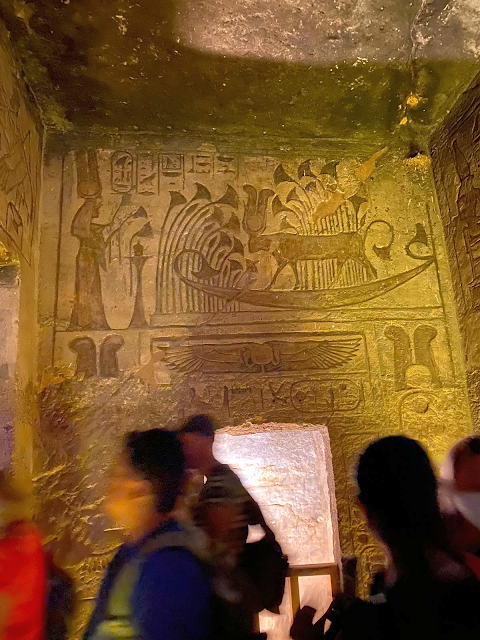
We finally reach the small sanctuary at the back of the temple.
The bas-reliefs in the sanctuary depict the king and queen making offerings to various ancient Egyptian gods. Of special interest is a sculpture cut into rock at the back wall in which goddess Hathor in the form of a cow is charging straight out of the rocks of the mountain.
We depart Abu Simbel for the long drive back to our Nile river cruise ship. Our ship then sails from Aswan to Edfu via Kom Ombo.
The Temple of Horus at Edfu
March 17, 2023

The Edfu temple is the second largest temple and one of the best preserved monuments in Egypt, remaining very nearly intact over its over 2,400-year old history thanks to it being buried for centuries under 40 feet of sand and silt from the Nile river until 1860 when French archeologist Auguste Mariett began dusting it off. The temple is the largest dedicated to Egyptian god Horus (Apollo to the Greeks) who is often depicted with the head of a falcon, and his wife the goddess Hathor. Great festivals took place here including annual celebrations marking the birth, coronation and battle victories of Horus, and arrival of his beloved wife the goddess Hathor from Denderah on their divine anniversary. Incidentally, a major celebration at Hathore's wonderful temple at Dandarah also marked her annual departure for Edfu.

The temple of Horus at Edfu is not that old by ancient Egyptian standards. Built by kings of the Macedonian Greek Ptolemaic dynasty after Alexander's conquest of Egypt, its construction was started by Ptolemy III Euergetes in 237 BCE and completed by Ptolemy XII Auletes in 57 BCE. The Macedonian Greeks built their temple over far older monuments as revealed in ruins and inscriptions around it dating from the period of New Kingdom (16th century BCE to 11th century BCE) referencing rulers Ramesses I, Seti I and Ramesses II of that era.
The arrival of Christianity in Egypt was accompanied with destruction of many of Edfu temple's carved bas-reliefs and attempts at burning down sections of it. The surviving sculptures on stone walls along with textual inscriptions are like comic strips in bas-relief. They tell stories about the birth and divine deeds of Horus, including the legend of Horus seeking revenge on his uncle the bad god Set (depicted as a hippopotamus) for the murder of his father Osiris and subsequent victory and coronation of Horus. Set (or Seth) is a god of deserts, storms, disorder, violence and foreigners.
Inside the sanctuary at the center of the temple, there is a remarkable shrine featuring Horus on a Egyptian holy boat called "sacred barque". Miniature sacred barques like these were imagined to have gods traveling in them and would be transported and placed just outside temples for the people to receive blessings from the on-board god.
Nile River Cruise to Luxor Across Esna Lock
March 17, 2023
Watch: Crossing the Esna Lock, Nile River, Esna, Egypt
Kings of the Macedonian Greek Ptolemaic dynasty (305 BCE - 30 BCE) initially commissioned a lock gate on Nile river to try to control water flow for reliable irrigation and navigation. Esna was chosen as a convenient location where conceptually the Nile river's upper part meets its lower part. The lock has been reworked and upgraded over centuries. In 1908 Abbas Hilmi II, the last Ottoman viceroy (Khedive) of Egypt and the Sudan, rebuilt the lock now referred to as the Old Esna lock. It was then redone again and reopened on New Years day, 1996 as the current Esna lock.
 |
| A cruise ship ahead of ours passes through Esna lock |
A marvel of engineering, the modern Esna lock has four automatic gates that open and close in turn to let ships through in about six minutes across a water level difference of 26 feet between the upper and lower Nile river. Watching the lock gates in operation as a Nile river cruise ship passes through it is an exciting experience and a welcome modern break from ancient monuments along the Egyptian tourist route.
Watch: Egyptian Belly Dance (Raqs Sharqi) Performance aboard our Nile River Cruise ship
We spent three nights on the Jaz Celebrity cruising the Nile river from Aswan to Luxor and had a gala time on the top deck between excursions to ancient Egyptian historic sites. One highlight of our cruise is a fantastic Raqs Sharqi (Egyptian classical belly dance). We joined the very beautiful dancer on her small stage in the dining area of our cruise ship and did our best to keep up with her amazing dance moves.
Luxor
March 18, 2023
Around 20th century BCE, there was a city on the east bank of river Nile whose citizens celebrated creator Amun-Ra as their patron god. They called it simply "the city" ("Wase") or "the southern city" ("Waset"). It became super important when designated the capital of Egypt, at first intermittently by pharaohs of the Middle Kingdom (2040 BCE to 1750 BCE) and then continuously by pharaohs over ancient Egypt's most glorious period of New Kingdom (1550 BCE to 1070 BCE). The biggest of Waset's temples, also dating back to the 20th century BCE, was also simply called "the temple".
With Alexander the Great's conquest of Egypt and subsequent rule by Macedonian Greek Ptolemaic dynasty, the city was assigned the name we see in history books today: Thebes, specifically "Thebes of a hundred gates" not to be confused with the Thebes in Greece that was obliterated by Alexander.
The Romans then arrived and renamed the city to Diospolis Magna (Great City of Zeus). Finally, with Arab takeover of Egypt, the city had the name by which we know it today: Luxor - the "city of the Palaces". "The temple" was also named by the Arabs to Karnak - "fortified village". Today that temple is the Precinct of Amun-Ra, the largest of four temples that make up the astounding Karnak Temple Complex.
Right across river Nile from the Karnak complex, on the west bank of Luxor, lie the astonishing monuments, temples and tombs of the Necropolis of Thebes including the legendary Valley of the Kings and Valley of the Queens.
Egypt currently draws 35,000 visitors every day and every single one of them is awestruck by what Egypt accomplished as demonstrated on the two banks of the Nile river at Luxor. Luxor is a life-changing experience.
Hot Air Balloon Ride over Luxor
Watch: Hot Air Balloon Ride over Luxor, Egypt
Our Hot Air Balloon operator picked us up at 4:30 AM from our cruise ship. We sail on a pretty boat to the launch site at west bank of river Nile at Luxor. Tea, coffee and breakfast snacks served on the way are very welcome!

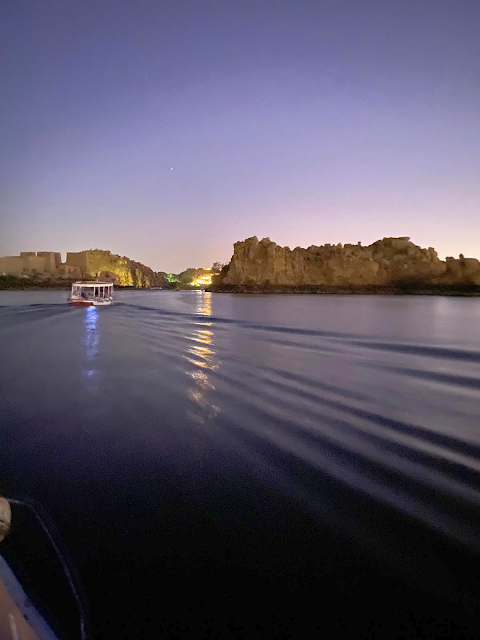
Our hot air balloon takes off just as the sun is rising over Luxor. We get some of the most memorable views of our lifetimes from the vantage point of the sky. No pharaoh ever has had an opportunity to look at the creations they commissioned like we do today!
Soon we are high up in the air trying to locate the places we will visit by car and foot later today: Valley of the Kings, Valley of the Queens, Colossi of Memnon, Mortuary Temple of Hatshepsut, Mortuary Temple of Seti I and even Karnak Temple and Luxor Temple across the Nile river on the east side of Luxor.

After the balloon ride, we return to our ship and bid farewell to our three-night home on the river Nile. We will explore the rest of Luxor by road and by foot.
The Valley of the Kings
 |
| View from entrance to the Valley of the Kings |
The Valley of the Kings is a VIP cemetery. It is often referred to as the "Theban Necropolis" given its location right across the Nile river from Thebes (now Luxor). The Egyptians cut out rock in the mountains here for over 500 years to build elaborately decorated tombs for pharaohs, royal family members and distinguished nobles. Royalty from the eighteenth, nineteenth and twentieth dynasties of the period of the New Kingdom (c.1550 BCE - 1069 BCE) is buried here, including the most popular pharaohs of today - Tutankhamun (1336-1327 BCE) and Ramesses II aka Ramesses the Great (1279-1213 BCE).
65 tombs have been unearthed so far. Some are simple and others elaborate. The KV5 tomb for sons of Ramesses II has 120 chambers just by itself. Ramesses the Great must have been a prolific father indeed!
The tombs have been disturbed and robbed by tomb raiders over centuries but are still very much worth visiting.
Only a limited number of tombs are open to visitors. Tickets are issued according to the number of "regular" tombs one wants to visit. The tombs of King Tut, Ramesses the Great and Seti I are special and tickets for them are sold separately in addition to the bundle tickets for "regular" tombs.
There is a neat plastic model at the visitor center that shows above and underground structures of the tombs along with a translator for hieroglyphs.

KV62: Tomb of Tutankhamun
Tutankhamun (c.1336–1327 BCE)
Here lies the handsome King Tut with an eternal smile on his face. His mask displayed at the Cairo museum is perhaps the most popularly recognized ancient egyptian artefact on the planet. As I wrote earlier (see Tutankhamun’s mask), taking his mask off meant literally dismembering him and putting him back together for display here.

Surprisingly, his final resting place is smaller, simpler and far less flashy than tombs of other pharaohs here. Scholars believe Tutankhamun's early death prompted his burial in a hurriedly improvised tomb originally meant for someone less important than royalty.

KV2: Tomb of Ramesses IV
Ramesses IV (c.1153–1147 BCE)

KV11: Tomb of Ramesses III
Ramesses III (c.1184–1153 BCE)

Mortuary Temple of Hatshepsut

In ancient Egyptian history, a "mortuary temple" is a monument close to royal tombs built to commemorate the rule of a reigning pharaoh with intended continued use of the temple by the ruling pharaoh's followers and successors after he (or she in the case of Hatshepsut) passes away. Sacrificial events were also organized in these temples.

Pharaoh Queen Hatshepsut (c.1507–1458 BCE) of the eighteenth dynasty was the second female pharaoh in Egypt's history. Due to reasons not very clear, later pharaohs attempted to erase her from Egyptian history and destroy her legacy. However, today her mortuary temple constructed during her 22-year reign between c.1479 and 1458 BCE is considered a masterpiece of ancient Egyptian architecture.

There is apparently a myrrh tree brought back from "Punt", thought to be somewhere on the horn of Africa or further south in Somalia to Kenya, by one of Hatshepsut's expeditions. This tree is depicted on temple walls too. There is indeed a tree stump in the indicated enclosure. Myrrh trees (Commiphora myrrha) are thorny shrubs that grow up to 16 feet tall. They secrete a resin from man-made incisions on their stem. This resin is collected and used for fragrance and medicinal purposes.

Vendors around the archeological complex demonstrate how vessels were made in ancient times and launch into typical sales pitches to tourists.
Colossi of Memnon
The Colossi of Memnon are two huge stone statues of pharaoh Amenhotep III (c.1390–1352 BCE) sitting on his throne. The statues were erected around 1350 BCE under two miles south of the temple of Hatshepsut. Smaller figures of Amenhotep III's wife Tiye and mother Mutemwiya are also carved into the stone thrones at the sides of his legs. God Hapi of annual Nile floods is carved into the sides of the thrones.
Much later, the Romans inscribed on the statues a bunch of Greek and Latin text about mythological Greek king Memnon of Aethiopia. The inscriptions initially threw modern archeologists off resulting in misnaming the statues after Memnon, a name which continues today. The statues should really be called the Colossi of Amenhotep III.
Precinct of Amun-Re, Karnak Temple, Luxor
We cross Nile river from the west side of Luxor to the east and arrive at the astonishing Karnak temple complex. The complex is a vast archeological site with four parts. As I mentioned above (see Luxor), the oldest and biggest part of the complex is the temple or Precinct of Amun-Ra, now around 4,000 years old! This Great Temple of Amun is the only part of Karnak open to the public. The other three parts (the Precinct of Mut, the Precinct of Montu and the dismantled Temple of Amenhotep IV) cannot be accessed by visitors.

Regardless, the Great Temple of Amun-Ra is majestic enough. It still counts itself among the largest religious structures ever built in the history of mankind.
Sphinx Avenue
The entrance to the Amun-Ra temple is via Sphinx Avenue (Avenue of Sphinxes) - a wide boulevard named for the lines of ram-headed Sphinx statues. Each Sphinx with the head of a ram sheep protects a pharaoh cradled under its chin. This boulevard designed for grand processions once ran all the way to the Temple of Luxor (now in downtown Luxor) a mile and a half away.
Barque-Temple of Ramesses III
To the south-west of the first court, south of the second pylon, lies the Barque-Temple of Ramesses III with two 20-foot statues at the entrance decorated with scenes of battle victories.
Obelisks of King Thutmose I and Queen Hatshepsut
Two super-tall obelisks are located behind the first pylon of the temple complex. The one at the left was erected by pharaoh queen Hatshepsut (c.1479–1458 BCE) and the one on the right by pharaoh Thutmose I (c.1504–1492 BCE).
The 97-foot 320-ton monolithic granite obelisk of Hatshepsut at Karnak temple complex is the tallest obelisk still standing in Egypt (the tallest standing ancient Egyptian obelisk in the world is the stupendous 150-foot 15th-century BCE Lateran Obelisk now in Rome, Italy where it is still the tallest obelisk of the country). Information carved into walls around the base of the obelisk reveal two such obelisks were cut from solid Aswan red granite rock, polished and decorated at the quarries of Aswan, shipped to Luxor and erected, all within 7 months in 1457 BCE!
The upper part of a second Hatshepsut obelisk built in 1457 BCE had been lying flat on the ground next to the Sacred Lake from 1920 when French Egyptologist George Legrain had rescued the broken piece. The original obelisk had collapsed in an earthquake long ago. Still missing its lower two-thirds, this remaining 36-foot upper part was re-erected recently in April of 2022 at the same location. The Egyptian Ministry of Tourism and Antiquities have announced a project to construct a new lower two-thirds and join the upper part on top thus re-creating the entire obelisk.
Great Hypostyle Hall
We next head to the Great Hypostyle Hall (c.1300 BCE) conceived and started by pharaoh queen Hatshepsut, almost totally built by pharaoh Seti I with some decorations of the southern wing completed by Ramesses II. There are outstanding bas-relief decorations carved during the reign of Seti I in the northern wing. Blank spaces on the walls were filled in with inscriptions during the reign of successors including Ramesses III, Ramesses IV and Ramesses VI. The hall is named "hypostyle" (an architectural term) because of its roof-over-column design. The roof is long gone but the columns remain in various states of degradation.

We are greeted by a colossus of Ramesses II with a smaller queen Nefertari between his ankles and feet outside the entrance to the Great Hypostyle Hall.
This is a huge 54,000 square-foot space with 134 columns arranged in 16 rows that once held a 80-foot high ceiling up. The columns are cut in the shape of stalks of papyrus plants and are intricately decorated. Papyrus-inspired columns are an ode to god Atum (a manifestation of creation sun god Ra who created himself and everything else in the universe) who rose from the waters of the Nile delta where papyrus plants grow.
Sacred Beetle of Amenhotep III
Towards the Sacred Lake, we see a huge granite statue of a beetle. This statue of a scarab beetle (dung beetle) is dedicated to Amenhotep III. Scarab beetles were very important in ancient Egypt, representing their religious belief system and the eternal cycle of life. Khepri, another manifestation of primordial creator sun god Ra who created himself and the universe, is god of sunrise and insects and pushes the sun up into our world every morning and down into the underworld every evening. Khepri is represented with the head of a scarab beetle.
The statue is strongly believed to bring wellness and good fortune. We were compelled to circle around the statue of the beetle for luck, success and happiness.
Sacred Lake of Karnak Temple
Built by pharaoh Thutmose III (c.1479–1425 BCE), the 400 ft x 250 ft Sacred Lake of Karnak Temple is fed by Nile river via a small canal and has discharge outlets on its east and west sides. Due to the clever design of the lake, it does not flood when the Nile floods and has actually maintained a constant water level for over 3,500 years now. The north and south sides have Nilometers used for predicting dates of all-important annual Nile river floods.
The lake has stairs leading into its water and was surrounded by residences for priests along with bird cages. Priests used the lake for bathing, cleansing and rituals. Ducks and birds were released on the lake and allowed to swim before being ritually sacrificed. However, the goose being one manifestation of god Ra-Amun, it is likely some geese were deemed sacred and allowed to use the lake as their home.
The Karnak Temple Sound and Light Show now takes place by this lake every evening.

Hurghada
March 18, 2023
From Luxor, we drove to Hurghada on the Red Sea coast some 188 miles and 4 hours away, checking into the Hilton Hurghada Plaza Resort. Hurghada is a touristy beach resort city perfect for relaxation after such an overwhelming educational tour of ancient Egyptian history.





We spend two nights at the Hurghada resort and head back to Cairo to fly home, marking the end of this trip.

































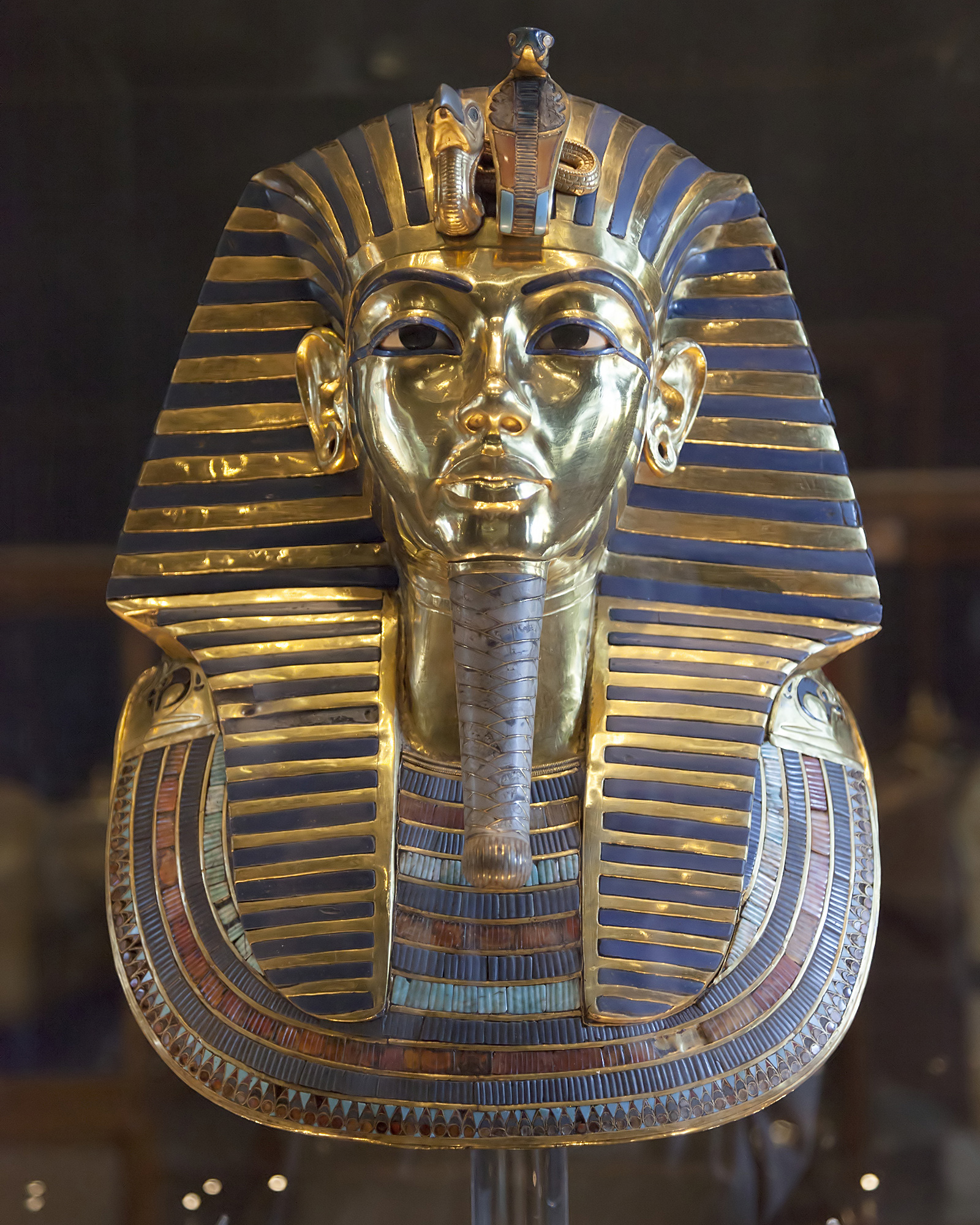
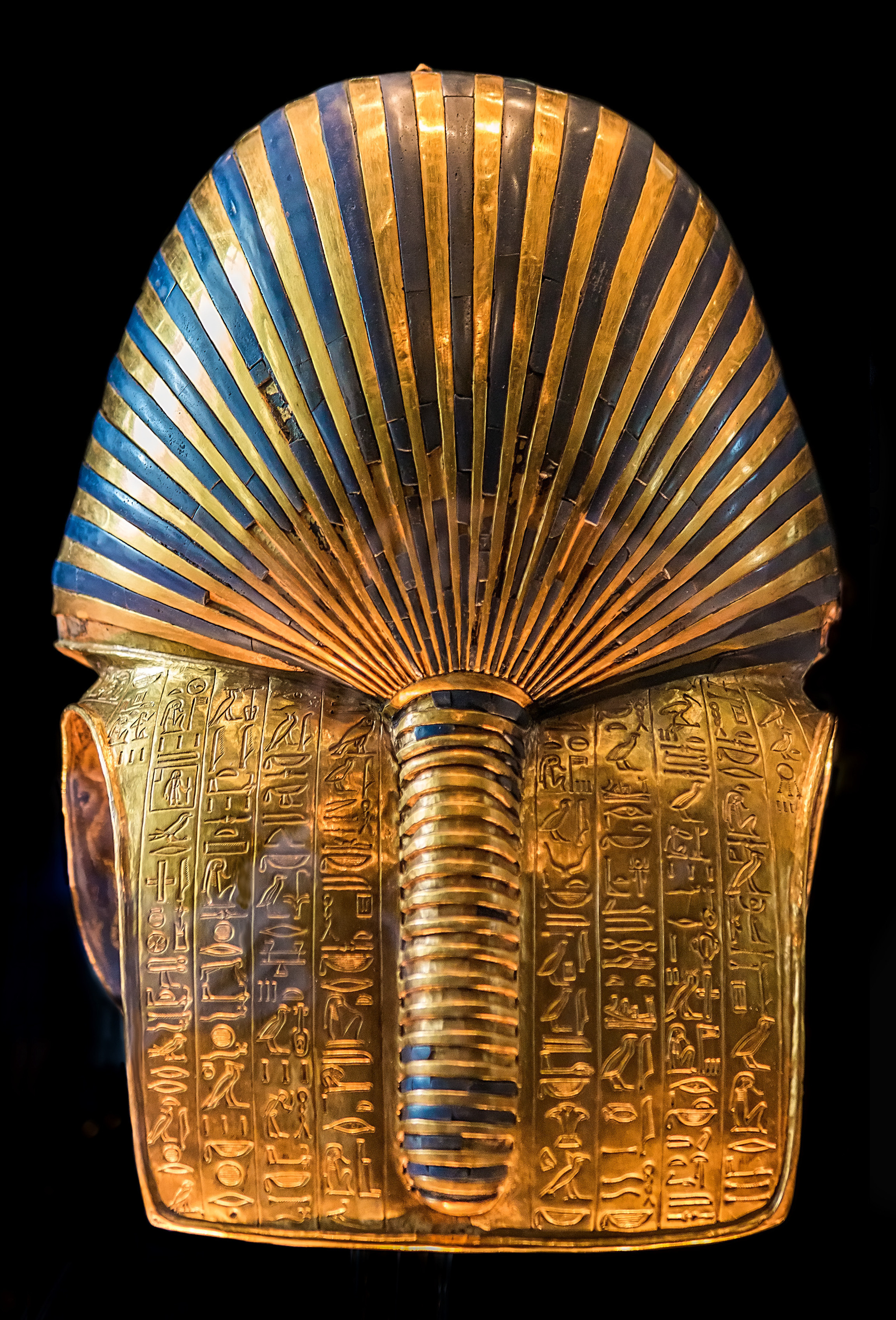




















































































































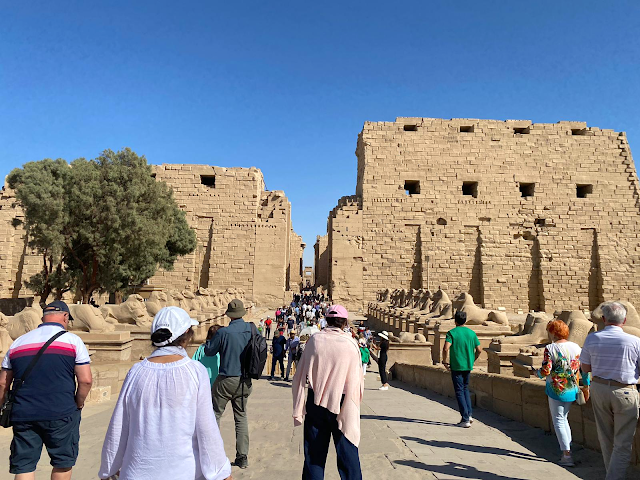















0 comments